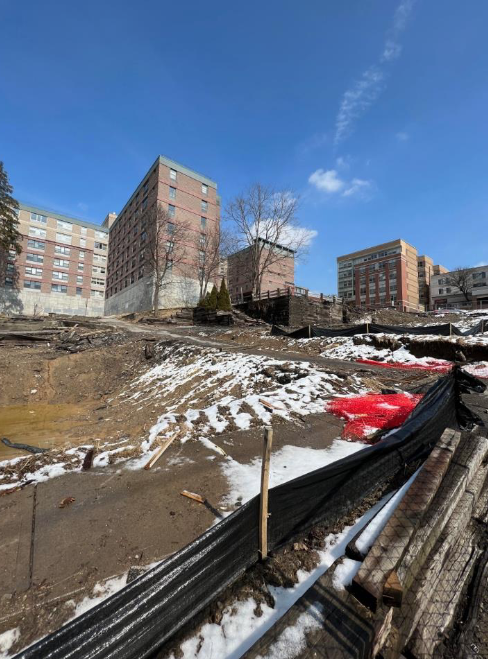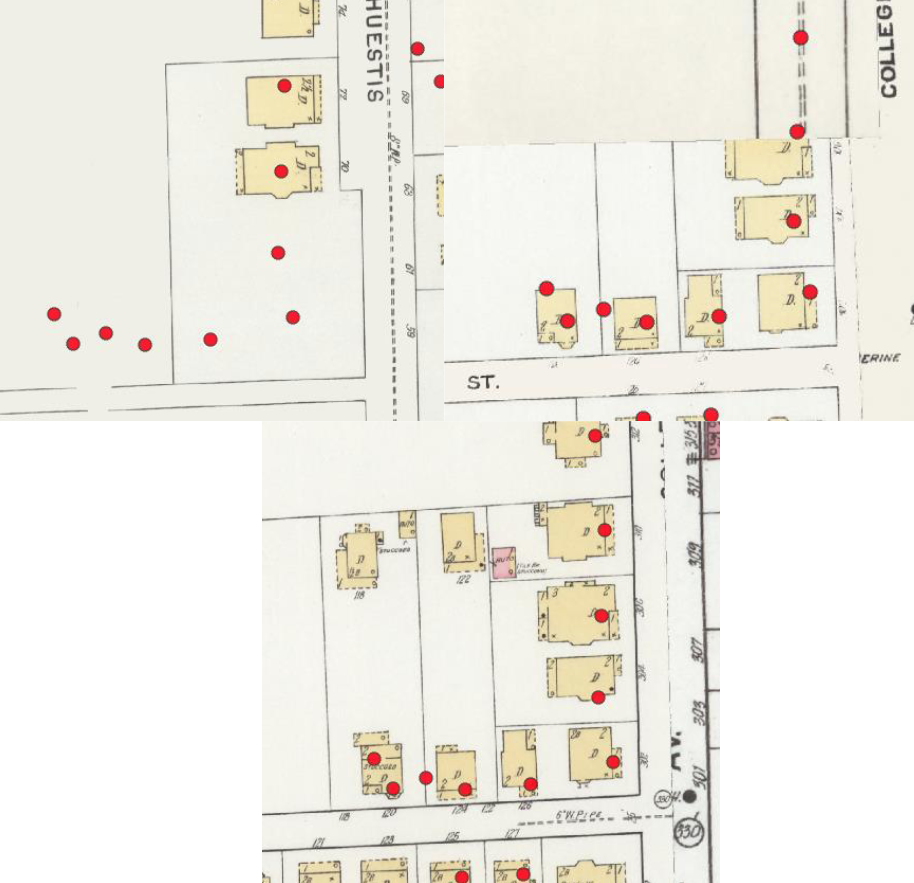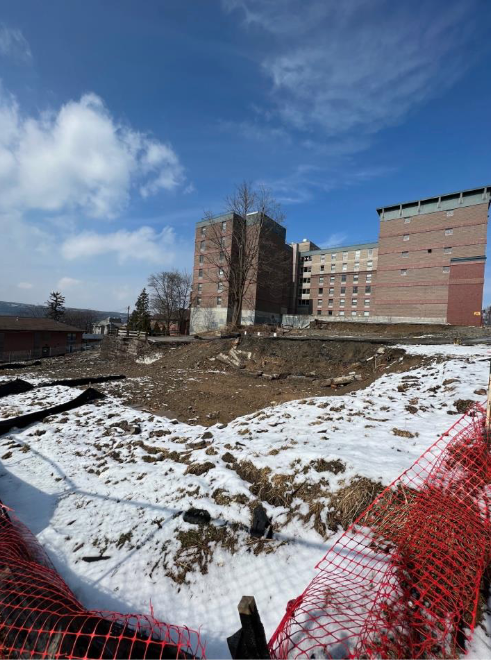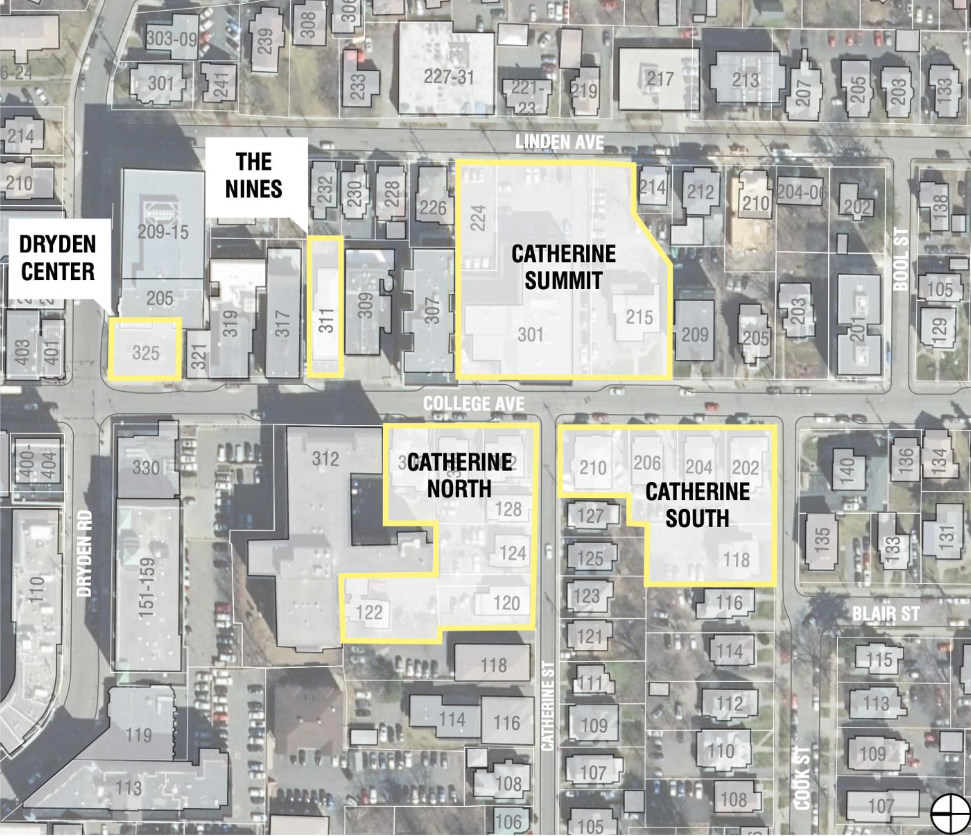Catherine North Project | Ithaca, New York
Report by Jonathan Robison

Current view from approximately 120 Catherine Street, Source: Jonathan Robinson, 2022
Introduction
In the Collegetown neighborhood of Ithaca, NY, the Catherine North project is a new residential development under construction. Part of the wider Collegetown Innovation District proposed by developers John Novarr and Philip Proujansky of Coll-Cath Associates, Catherine Commons is the first stage of the project. It proposes replacing eleven standalone apartment houses with six new apartment buildings. The project is split between two portions, with three apartment buildings each on the north and south sides of Catherine Street at the intersection with College Avenue. The focus of this report will be on the Catherine North portion of this project. Catherine Commons, and the wider Collegetown Innovation District proposal, promises to radically transform the streetscape and life of Collegetown and usher in a new era of major development in the city’s most expensive neighborhood (Crandall, 2021a).
Location

Catherine North is situated at the northwest corner of Catherine St. and College Ave. in the heart of Collegetown. Catherine North’s footprint consumes and consolidates the footprint of seven individual lots and buildings –306, 304, and 302 College Ave. and120, 122, 124, and 128 Catherine St.
The seven buildings that originally made up the new parcel were all stand alone, wood framed homes. County property records do not list their years of construction, though306 College Ave. is present on the 1898 Sanborn Fire Insurance Atlas and all are present on the 1919-1920edition of the same map. Overall, they were typical of the residential vernacular architecture from the turn of the twentieth century that define many parts of Collegetown.
According to property records, all seven were purchased by Coll-Cath Associates, LLC on December 12, 2018, for a collective $15.593 million (Crandall, 2018). After holding the parcels for several years, the developer announced their plans to create the Collegetown Innovation District in a planned unit development application submitted to the City of Ithaca on November 12, 2020(Crandall, 2020). The PUD application included plans for five separate developments along College Ave., including the Catherine North site.While the overall PUD faced challenges for collective approval before Ithaca governing bodies like the Ithaca Planning & Development Board and the Ithaca Board of Zoning Appeals, the developers decided to move forward in a more piecemeal style and sought approval for the demolition of the existing homes and approval of the proposed buildings for Catherine North and South (Harding, 2021b).While the existing houses were already large apartment houses, the proposed plan will create significantly higher density and extend Collegetown’s higher intensity commercial and residential spine further southward down College Ave.
The proposed Catherine Commons would collectively replace 150 beds of student housing in the eleven apartment houses for 489 beds in the six new buildings (Crandall, 2021b).According to paperwork submitted to the city, the total development for Catherine Commons will contain 265,000 ft2 of space over 360 apartments, including 2,600 ft2of commercial space. In preparation for this new development, all eleven rental structures were vacated, and environmental remediation conducted to remove asbestos and other containments. Following completion of the environmental review process, the developers finally received permission to demolish the structures and did so in the closing weeks of 2021 and first weeks of 2022.The developer estimated in the preliminary site plan review that the demolition would create about 1,480 tons of waste. The new building along College Ave. would align with the face of neighboring 312 College Ave. at the northeast corner but would create a street-level setback at the corner with Catherine St. to create additional public and pedestrian space there(Catherine Commons Preliminary Site Plan Review Application Report, 2021).
The seven parcels for Catherine North are split between two different zoning classifications. The three parcels lining College Ave. are zoned for MU-2, allowing for mixed use structures of up to 80’ in height and 6 stories. The four parcels along Catherine St. are at a significant grade, sloped downward to the west. They are zoned for CR-4, a special ‘Collegetown Residential’ zoning classification that allows for multiple dwellings or other uses(Official Zoning Map of the City of Ithaca, 2018). The city’s zoning code for the parcels are based on the 2014 Collegetown Area Form Districts, a zoning and form code that specifically regulates building design and development requirements within the neighborhood. Additionally, the 2017 Collegetown Design Guidelines provides developers with a discretionary set of aesthetic standards in the neighborhood to promote good design.
Context of Parcel
Catherine North is surrounded by a mix of adjacent property types. Directly to the north is 312 College Ave, one of the largest apartment buildings in Collegetown. East across College Ave. are several similar apartment buildings, including Collegetown Crossing at 307 College Ave, and 301 College Ave. Both 307 and 301 College Ave. contain commercial space on their first floors, GreenStar Co-op and Jason’s Grocery respectively. Catherine North would complete the streetscape’s transformation toward more apartment towers and commercial space fronting College Ave. To the south and west of the plot along Catherine St. are large wood framed apartment houses that define much of Collegetown and date from the early part of the 20th century. Beyond the directly adjacent properties, Collegetown is one of the main high-density commercial and residential districts in Ithaca. Named for its location just over Cascadilla Gorge from Cornell’s campus, the neighborhood is situated at the crest of East Hill, about 400 feet above downtown Ithaca, and predominantly inhabited by Cornell students and the businesses that cater to them. The high-density core of the neighborhood is east-west along Dryden Ave between Eddy St. and Linden Ave. and north-south along College Ave. between OakAve. Catherine St. This area is typified by larger student apartment buildings with commercial space for shops and restaurants on their first floors.
Beyond the core, Collegetown is known for its large wooden houses from the late 19th and early 20th century. While many were likely once single-family dwellings, they have since been converted into apartment units or large student dwelling units. Just to the west of Collegetown is the East Hill Historic District, a locally and nationally designated district which protects a concentration of 273 historic properties built between 1830 and 1932 (Harding, 2021a). While many structures in Collegetown similarly date from within this period, they lack the historic integrity of the structures found within the district.
For Catherine North, the developers are proposing an eight-story structure lining College Ave. and two four story structures along Catherine St. The scale of the building along College Ave particularly is significant, exceeding the current zoning allowance by two floors and 10 feet of height, and will require a variance from the city zoning board (Crandall, 2021b).
Observations

Previous to demolition, the houses had been left vacant for well over a year. Currently all the parcels are vacant land, with the houses now completely demolished down to and including their foundations. While the approval process for Catherine Commons is moving along steadily and appears to be rolling towards final approval, the combined vacancy and demolition certainly leave an impact on the area. These actions have left a years long emptiness in Collegetown –first from the decreased street life of removed residents and businesses and now for the gaping holes in the ground that leave the area wide open.Relatively little detailed individual information is available about the homes demolished. Current county property records now contain little data as the sites are classified as vacant commercial land. Individually the structures were unremarkable for the area. However, collectively their loss serves as a harbinger of the significant changes underway in Collegetown, already one of the fastest developing regions of the city.
The site and project are also unique in regard to the demolition process. While typically these type of wood framed houses would be wholesale demolished and dumped into landfill, local community organizations conducted a significant effort to save certain portions of the homes and recycle their finishes if possible. The Cornell University Circular Construction Lab and CR0WD (Circularity, Reuse and Zero Waste Development)led the effort to salvage these materials and strip the structures of reusable elements. This includes wood flooring, decorative finishes, lights fixtures, appliances, and doors among others. These materials will be prepped for reuse and are part of the movement towards cutting down on landfill waste from construction and sparking a ‘greener’ way of reprocessing demolished buildings. The deconstruction and salvage operations in Collegetown for Catherine Commons were a pilot of sorts, to help outline future policies that the City of Ithaca could implement for future deconstructions(Canny, 2022)(Dean, 2022).
Given their location along the central spine of Collegetown, their poor to average condition, and the heated property market in Collegetown, these apartment houses were ripe for collective purchase and redevelopment. Since the city zoned these parcels for alternatively large multi-use structures or multi-unit residences, the untapped potential and value of the land underneath them was worth more than the structures themselves. It is easy to imagine this type of demolition and redevelopment spreading further down the spine of College Ave. toward Mitchell St.to other parcels zoned CR-4.

Sources
Canny, A. (2022, February 2). Rather than demolish buildings, Cornell researchers propose ‘deconstruction’ in Ithaca | WSKGWSKG. https://wskg.org/rather-than-demolish-buildings-cornell-researchers-propose-deconstruction-in-ithaca/
Catherine Commons Preliminary Site Plan Review Application Report. (2021). https://cityofithaca.org/DocumentCenter/View/13251/SPR-App-Catherine-Commons-2021-08-16?bidId=
Crandall, B. (2018, December 20). Developer drops $15.6 million in massive Collegetown buy. The Ithaca Voice. http://ithacavoice.com/2018/12/developer-drops-16-million-is-massive-collegetown-buy/
Crandall, B. (2020, November 13). Collegetown “Innovation District”goes public. The Ithaca Voice. http://ithacavoice.com/2020/11/collegetown-innovation-district-goes-public/
Crandall, B. (2021a, August 23). Collegetown property changes hands with $16.5 million sale. The Ithaca Voice. http://ithacavoice.com/2021/08/collegetown-property-changes-hands-with-16-5-million-sale/
Crandall, B. (2021b, September 9). Plans submitted for “Catherine Commons” Collegetown development. The Ithaca Voice. http://ithacavoice.com/2021/09/plans-submitted-for-catherine-commons-collegetown-development/
Dean, J. (2022, February 16). Unbuild better: A Collegetown case study in deconstruction. Cornell Chronicle. https://news.cornell.edu/stories/2022/02/unbuild-better-collegetown-case-study-deconstruction
Harding, T. (2021a, May 11). East Hill Historic District could expand by 19 properties. Ithaca Times. https://www.ithaca.com/news/ithaca/east-hill-historic-district-could-expand-by-19-properties/article_cd5cc5e4-b2ae-11eb-abde-ab98460a2eed.html
Harding, T. (2021b, November 2). Collegetown ‘Catherine Commons’ plan gets broad Planning Board support. Ithaca Times. https://www.ithaca.com/news/ithaca/collegetown-catherine-commons-plan-gets-broad-planning-board-support/article_5b5f3956-3c2c-11ec-af3b-a7cdb1f65a7f.html
Official Zoning Map of the City of Ithaca. (2018, April 10). http://www.cityofithaca.org/DocumentCenter/View/1436/City-of-Ithaca-Official-Zoning-Map-PDF?bidId=


